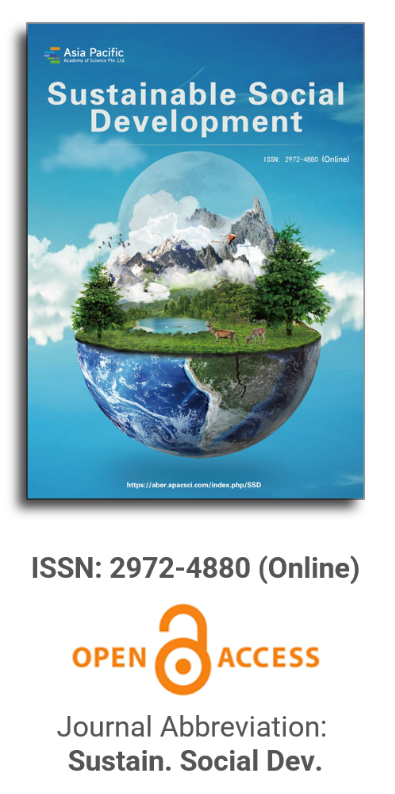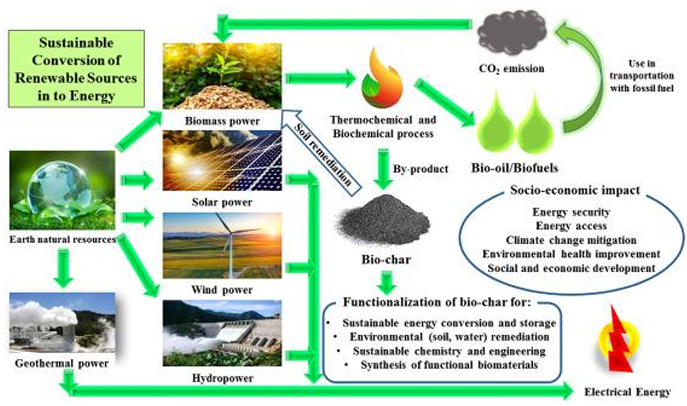
Asia Pacific Academy of Science Pte. Ltd. (APACSCI) specializes in international journal publishing. APACSCI adopts the open access publishing model and provides an important communication bridge for academic groups whose interest fields include engineering, technology, medicine, computer, mathematics, agriculture and forestry, and environment.

The impact of land use and cover changes on river flows in Wundanyi Catchment of Taita Hills, Kenya (1970–2030)
Vol 2, Issue 3, 2024
Download PDF
Abstract
Taita Hills are one of the most important biodiversity hotspots of Kenya but are experiencing a high rate of deforestation due to the to the conversion of its original forestland to agriculture and settlement during the last century. These landscape dynamics, coupled with rainfall fluctuations in these critical ecosystems, may significantly affect water resource distribution and food security in Taita Taveta County and its environs. This study aimed to establish the trends of land use/cover change (LUCC) in the Wundanyi catchment from 1970 to 2030 and predict their specific and combined effects on surface runoff and stream flow in the same period. The analysis was based on statistical trend analysis and dynamic landscape modeling using both historical and primary data from the Wundanyi catchment and Landsat TM and ETM+ imagery of Taita Hills for 1990, 2000, and 2010. Results show highly variable mean seasonal and annual values of discharge in Wundanyi catchment, probably attributed to environmental changes affecting Taita Hills in general and Wundanyi catchment in particular. Compared to 1990, major land use/cover changes in 2010 were featured by the expansion of built-up area (250%), plantation forest (23.7%), broadleaved forest (17.4%), and thicket (15.9%). It was also notable the decrease in woodland (−30.3%), cropland (−21.6%), and shrubland (−0.8%). Dynamic spatial trends by the year 2030 will be evidenced by increased thicket by 0.41% per annum (R2 = 81.6%) and by decreased plantation forests (−0.13%; R2 = 91.3%), woodland (−0.10%; R2 = 77.6%), shrubland (−0.11%; R2 = 85.2%), broadleaved forests (−0.03%; R2 = 56.6%) and cropland (−0.09%; R2 of 84.4). These changes will shape the catchment landscape and influence its hydrology, unless the existing forest and agricultural policy interventions are enforced. Hence, crop diversification, agroforestry, and soil and water conservation structures are recommended to maintain effective control of LUCC on hydrological processes going on in the Wundanyi catchment.
Keywords
References
- UN. Sustainable Goals Report 2022. Available online: https://unstats.un.org/sdgs/report/2022/The-Sustainable-Development-Goals-Report-2022.pdf (accessed on 11 January 2024).
- Guzha AC, Rufino MC, Okoth S, et al. Impacts of land use and land cover change on surface runoff, discharge and low flows: Evidence from East Africa. Journal of Hydrology: Regional Studies. 2018; 15: 49-67. doi: 10.1016/j.ejrh.2017.11.005
- Velastegui-Montoya A, Montalván-Burbano N, Peña-Villacreses G, et al. Land Use and Land Cover in Tropical Forest: Global Research. Forests. 2022; 13(10): 1709. doi: 10.3390/f13101709
- Chen H, Fleskens L, Baartman J, et al. Impacts of land use change and climatic effects on streamflow in the Chinese Loess Plateau: A meta-analysis. Science of The Total Environment. 2020; 703: 134989. doi: 10.1016/j.scitotenv.2019.134989
- Shah SA, Jehanzaib M, Lee JH, et al. Exploring the Factors Affecting Streamflow Conditions in the Han River Basin from a Regional Perspective. KSCE Journal of Civil Engineering. 2021; 25(12): 4931-4941. doi: 10.1007/s12205-021-0151-5
- Guzha AC, Rufino MC, Okoth S, et al. Impacts of land use and land cover change on surface runoff, discharge and low flows: Evidence from East Africa. Journal of Hydrology: Regional Studies. 2018; 15: 49-67. doi: 10.1016/j.ejrh.2017.11.005
- Kipchumba L, Cornu E. Climate Change Action in the Water Sector in Kenya: Status Review. Available online: https://publications.aecom.com/media/files/ClimateActionWaterSectorKenyaStatusReview.pd (accessed on 11 January 2024).
- UNICEF. 2017 Impact Report. Available online: https://www.unicef.org/kenya/media/471/file/Kenya-0000062.pdf.pdf (accessed on 11 January 2024).
- Wekesa C, Kirui BK, Maranga EK, et al. The Fate of Taita Hills Forest Fragments: Evaluation of Forest Cover Change between 1973 and 2016 Using Landsat Imagery. Open Journal of Forestry. 2020; 10(01): 22-38. doi: 10.4236/ojf.2020.101003
- Hassan Z, Shabbir R, Ahmad SS, et al. Dynamics of land use and land cover change (LULCC) using geospatial techniques: a case study of Islamabad Pakistan. SpringerPlus. 2016; 5(1). doi: 10.1186/s40064-016-2414-z
- KTWA. Distribution of Water Towers in Kenya. Available online: https://watertowers.go.ke/water-towers/ (accessed on 11 January 2024).
- Maeda EE. The future of environmental sustainability in the Taita Hills, Kenya: Assessing potential impacts of agricultural expansion and climate change. Fennia. 2012; 190 (1): 41–59. ISSN 1798-5617
- Pellikka PKE, Heikinheimo V, Hietanen J, et al. Impact of land cover change on aboveground carbon stocks in Afromontane landscape in Kenya. Applied Geography. 2018; 94: 178-189. doi: 10.1016/j.apgeog.2018.03.017
- MoALFC. Kenya County Climate Risk Profile: Taita Taveta County. Nairobi; 2021.
- Ndalilo LA, Maranga EK, Kirui BK. Land Use and Land Cover Change along River Lumi Riparian Ecosystem in Kenya: Implications on Local Livelihoods. Open Journal of Forestry. 2021; 11(03): 206-221. doi: 10.4236/ojf.2021.113014
- Gaur S, Singh R. A comprehensive review on land use/land cover (lulc) change modeling for urban development: Current status and future prospects. Sustainability. 2023; 15(2): 903. doi: 10.3390/su15020903
- Arnold JG, Williams, JR, Srinivasan R, et al. Soil and Water Assessment Tool Manual. USDA Agricultural Research Service, Texas; 2000.
- Janjić J, Tadić L. Fields of Application of SWAT Hydrological Model—A Review. Earth. 2023; 4(2): 331-344. doi: 10.3390/earth4020018
- Anaba LA, Banadda N, Kiggundu N, et al. Application of SWAT to Assess the Effects of Land Use Change in the Murchison Bay Catchment in Uganda. Computational Water, Energy, and Environmental Engineering. 2017; 06(01): 24-40. doi: 10.4236/cweee.2017.61003
- Ware HH, Chang SW, Lee JE, et al. Assessment of Hydrological Responses to Land Use and Land Cover Changes in Forest-Dominated Watershed Using SWAT Model. Water. 2024; 16(4): 528. doi: 10.3390/w16040528
- Islam K, Jashimuddin M, Nath B, et al. Land use classification and change detection by using multi-temporal remotely sensed imagery: The case of Chunati wildlife sanctuary, Bangladesh. The Egyptian Journal of Remote Sensing and Space Science. 2018; 21(1): 37-47. doi: 10.1016/j.ejrs.2016.12.005
- Lemenkova P. Modelling Landscape Changes and Detecting Land Cover Types by Means of the Remote Sensing Data and ILWIS GIS. Available online: https://www.researchgate.net/publication/337559838_Modelling_Landscape_Changes_and_Detecting_Land_Cover_Types_by_Means_of_the_Remote_Sensing_Data_and_ILWIS_GIS (accessed on 1 May 2024).
- ICPAC. Report on Historical Climate Baseline Statistics for Taita Taveta, Kenya. Available online: https://www.icpac.net/documents/265/Kenya-Climate_baselines_Report_ACREI-Print_Copy_sVprJAj.pdf (accessed on 11 January 2024).
- Nyambariga FK, Opere AO, Kituyi E, et al. Climate change scenario projections and their implications on food systems in Taita Taveta County, Kenya. Benkeblia N, ed. PLOS Climate. 2023; 2(6): e0000114. doi: 10.1371/journal.pclm.0000114
- Mkaya DM, Mutua BM, Kundu PW. Evaluation of The Impact of Land Use Change on Catchment Hydrology: The Case of Wundanyi River Catchment in Taita Hills, Kenya. Egerton University; 2013.
- Sun B, Robinson D. Comparisons of Statistical Approaches for Modelling Land-Use Change. Land. 2018; 7(4): 144. doi: 10.3390/land7040144
- KNBS. 2019 Kenya Population and Housing Census Results. The Regal Press Kenya Ltd; 2019.
- Obunga G, Siljander M, Maghenda M, et al. Habitat suitability modelling to improve conservation status of two critically endangered endemic Afromontane forest bird species in Taita Hills, Kenya. Journal for Nature Conservation. 2022; 65: 126111. doi: 10.1016/j.jnc.2021.126111
- Mkuzi HT. Assessment of Land Tenure, Land Use and Land Cover Changes in Taita Hills Forest Fragments: A Case Study of Ngerenyi Forest Fragments in Taita Taveta County, Kenya. Pwani University; 2020; Unpublished work.
- Jaetzold R, Schmidt H, Hornetz B, et al. Coast Province: Taita-Taveta County. Farm Management Handbook of Kenya. Ministry of Agriculture; 2012. p. 46
- Kithiia SM. A Critical Analysis of the Water Quality Impacts on Water Resources in the Athi River Drainage Basin, Kenya. Water Quality—Factors and Impacts. 2022. doi: 10.5772/intechopen.99667
- FAO. Global Forest Resources Assessment 2005, Main Report. Progress Towards Sustainable Forest Management. FAO Forestry; 2006.
- Leul Y, Assen M, Damene S, et al. Effects of Land-Use Dynamics on Soil Organic Carbon and Total Nitrogen Stock, Western Ethiopia. Applied and Environmental Soil Science. 2023; 2023: 1-12. doi: 10.1155/2023/5080313
- Li Y, Liu W, Feng Q, et al. Effects of land use and land cover change on soil organic carbon storage in the Hexi regions, Northwest China. Journal of Environmental Management. 2022; 312: 114911. doi: 10.1016/j.jenvman.2022.114911
- Kumar M, Denis DM, Kundu A, et al. Understanding land use/land cover and climate change impacts on hydrological components of Usri watershed, India. Applied Water Science. 2022; 12(3). doi: 10.1007/s13201-021-01547-6
- Chu X, Lu Z, Wei D, et al. Effects of Land Use/Cover Change (LUCC) on the Spatiotemporal Variability of Precipitation and Temperature in the Songnen Plain, China. Journal of Integrative Agriculture. 2022; 21(1): 235-248.
- Dogan FN, Karpuzcu ME. Effect of land use change on hydrology of forested watersheds. Ecohydrology. 2021; 15(1). doi: 10.1002/eco.2367
- Arantes LT, Carvalho ACP, Carvalho APP, et al. Surface runoff associated with climate change and land use and land cover in southeast region of Brazil. Environmental Challenges. 2021; 3: 100054. doi: 10.1016/j.envc.2021.100054
Supporting Agencies
Copyright (c) 2024 Joy A. Obando, Cush N. Luwesi, Rose Adhiambo Akombo
License URL: https://creativecommons.org/licenses/by/4.0/

This site is licensed under a Creative Commons Attribution 4.0 International License (CC BY 4.0).

Prof. Kittisak Jermsittiparsert
University of City Island, Cyprus






It is with deep regret that we announce the cancellation of the Forum on Sustainable Social Development & Computing and Artificial Intelligence, originally scheduled for June 15, 2025.

